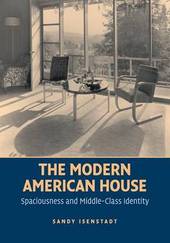
|
The Modern American House: Spaciousness and Middle Class Identity
Paperback / softback
Main Details
| Title |
The Modern American House: Spaciousness and Middle Class Identity
|
| Authors and Contributors |
By (author) Sandy Isenstadt
|
| Physical Properties |
| Format:Paperback / softback | | Pages:344 | | Dimensions(mm): Height 251,Width 175 |
|
| Category/Genre | Theory of architecture
Architectural structure and design
History of architecture |
|---|
| ISBN/Barcode |
9781107675063
|
| Classifications | Dewey:728.3709730904 |
|---|
| Audience | | Professional & Vocational | |
|---|
|
Publishing Details |
| Publisher |
Cambridge University Press
|
| Imprint |
Cambridge University Press
|
| Publication Date |
9 June 2014 |
| Publication Country |
United Kingdom
|
Description
Sandy Isenstadt examines how architects, interior designers, and landscape designers worked to enhance spatial perception in middle class houses visually. The desire for spaciousness reached its highest pitch where it was most lacking, in the small, single-family houses that came to be the cornerstone of middle class life in the nineteenth century. In direct conflict with actual dimensions, spaciousness was linked to a tension unique to the middle class - between spatial aspirations and financial limitations. Although rarely addressed in a sustained fashion by theorists, practitioners, or the inhabitants of houses themselves, Isenstadt argues that spaciousness was central to the development of modern American domestic architecture, with explicit strategies for perceiving space being pivotal to modern house design. Through professional endorsement, concern for visual space found its way into discussion of real estate and law.
Author Biography
Sandy Isenstadt is Assistant Professor of Art History at Yale University. A scholar of modern architecture, he has written on the work of Richard Neutra, Josep Lluis Sert, Leon Krier, and Rem Koolhaus. His work has been supported by the Center for Advanced Study of the Visual Arts (National Gallery of Art), the National Endowment for the Humanities, and the Graham Foundation.
Reviews'The book's themes are always intriguing. With its emphasis on viewers' experience of spaciousness rather than architects creating spaciousness, the book fits into recent vernacular architecture studies that examine inhabitation as a primary influence on buildings.' Journal of the Society of Architectural Historians 'Isenstadt's book shines as a model of interdisciplinary writing ... His scholarly thoroughness and rhetorical openness make his work a pleasure to read and contemplate.' The American Historical Review
|